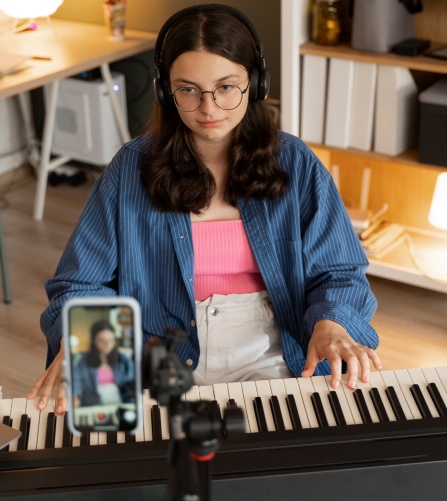Auditioning for the Department of Music

Photographer: Meredith Forrest Kulwicki
The University at Buffalo’s Department of Music welcomes talented musicians to audition for our undergraduate programs (MusB and BA), performance minors, graduate programs (MM and DMA) and Advanced Certificate. Auditions are held throughout the academic year for both fall and spring semester enrollments.
Current UB students and prospective students:
- Students who want to declare a music major or performance minor
- Students that want to take studio lessons for credit (non-major)
- Prospective majors (transfer students, high school seniors)
- Prospective graduate students (MM, DMA, or certificate)
- Saturday, Jan. 24 from 10–1 p.m.
Baird Recital Hall (250 Baird Hall)
Prospective majors and graduate students only:
- High schoolers
- Transfer students applying to UB
- Prospective graduate students (MM, DMA, or certificate)
- Sunday, Feb. 8, from 10 a.m.–1 p.m.
- Saturday, Feb. 14, from 11 a.m.–2 p.m. - Syosset High School, Long Island
- Friday, Feb. 20, from 2–5 p.m.
- Sunday, March 1, from 10 a.m.–1 p.m.
- Sunday, March 29, from 10 a.m.–1 p.m.
- Sunday, April 26, from 1–2 p.m.
(UB Accepted Students’ Day)
Baird Recital Hall (250 Baird Hall)
We want to hear your best, so review our suggested repertoire (audition requirements see below) to guide your preparation.
- Voice auditions will be accompanied. Please contact Michael Serio before your scheduled time to coordinate.
- Instrumental auditions do not require accompaniment.
- Video auditions are accepted for prospective music majors and MM applicants. Just include a link to your performance when submitting your department or graduate application.
🎥 Note: Video submissions are for prospective majors only—not for studio lessons or minor auditions. To be eligible for Department of Music merit-based scholarship awards, prospective undergraduate majors should audition in person.
Apply for a Music Major or Performance Minor!
Follow these steps to begin your undergraduate musical journey at UB:

Step 1: Apply to UB
- Complete the Undergraduate Application.
- Indicate your intended major or minor in music.
- Review deadlines and criteria on the Undergraduate Admissions page.

Step 2: Submit music application
- Complete the Department of Music application form.
- Request your preferred audition date.

Step 3: Audition
- Auditions are required for MusB in Performance, BA in Music and Music Performance minor.
- Choose an audition date during the academic year.
- Prepare repertoire based on the specific instrument or voice requirements.
The Department of Music awards merit-based scholarships ranging from $1,000 to $3,000 to outstanding undergraduate music majors. To be eligible, prospective undergraduate majors should audition in person.
Undergraduate Audition Requirements
Violin
- A movement from Bach's “Unaccompanied Sonatas and Partitas.”
- A movement from a standard concerto (e.g., Bruch, Mozart, Mendelssohn).
- An etude, showpiece, or contemporary work.
Viola
- Major and minor scales/arpeggios in 3 octaves.
- A movement from a Bach Gamba Sonata or equivalent baroque piece.
- A classical, romantic or contemporary work.
Cello
- Major/minor scales in 2-3 octaves.
- A movement from any Suite by J.S. Bach or an etude of moderate difficulty.
- A work by Fauré, Bruch, Saint-Saens, or similar.
Double Bass
- Major/minor scales and arpeggios in 2 octaves.
- An etude (Simandl Book II or equivalent).
- Two movements from a sonata (Marcello or Vivaldi).
- A classical, romantic, or contemporary piece.
- Sight-reading.
- Prepare three memorized vocal pieces:
- A 17th/18th-century Italian aria.
- An art song in German or French.
- A 20th-century English song (classical or musical theater).
An accompanist will be provided. Bring your scores, and please make sure your selections are appropriate for your voice level!
- All major scales (2 octaves) and chromatic scales (2 octaves).
- One of the following:
- An etude or characteristic study.
- One movement from a concerto or sonata.
- Sight-reading.
Snare Drum
- Basic rudiments and one intermediate/advanced solo or etude.
- Sight-reading.
Keyboard Percussion
- Scales (2 octaves) and one solo or etude on marimba or xylophone.
Timpani
- Ear tests (matching pitches, interval identification).
- One etude or solo.
Contact Thomas Kolor for assistance with substitute repertoire.
- Prepare three memorized pieces:
- A work by J.S. Bach.
- One movement from a classical sonata.
- A 19th/20th-century piece.
- Scales and sight-reading.
- A Prelude and Fugue or other large-scale work by J. S. Bach or other Baroque composer.
- A choral prelude by J.S. Bach.
- An organ work from the 19th , 20th or 21st century by a major composer.
- Sight-reading.
- Modifications may be made with the prior consent of the organ instructor.
- Two to three contrasting works.
- Knowledge of all major and minor scales and arpeggios is recommended.
- Contact Sungmin Shin for more details.
For information on auditioning for ensembles (open to UB students and Buffalo community members), visit the specific ensemble pages. Popular ensembles include:

The Chamber Singers.
- Non-majors, including graduate students, can request lessons with UB faculty.
- Beginners are encouraged to take group beginner courses in piano or guitar.
The Department of Music gladly accepts video auditions, though in-person auditions are preferred when possible.
Steps to submit a video audition
- Select an Audition Date: When scheduling your audition, choose a date even if you intend to submit a video.
- Record Your Audition: Follow the guidelines provided for your specific instrument or voice.
- Submit Your Video: Send the completed audition video to Mary McCarthy by the audition date you selected.
Video audition recording tips
- Equipment: Use a smartphone or tablet for high-quality recording.
- Framing: Film horizontally, ensuring full visibility of the performer.
- Lighting: Place a light source in front of you.
- Sound: Position the microphone unobstructed in a central location.
- File Sharing: Large files can be uploaded to the UBbox, Google Drive or Dropbox.


